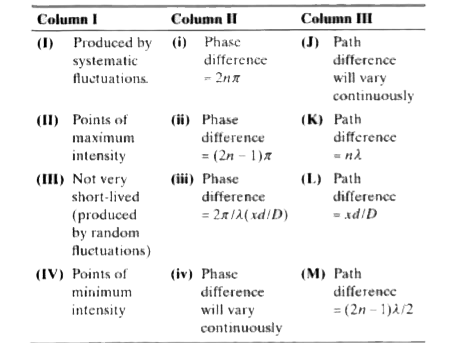In the given table, column I shows the different types of decays in nuclear fission, collumn II show the change in the element which undergoes decay and Column III shows properties of different types of decays.

What are the characteristics of the below nuclear equation?
(mother nucleus) (daughter nucleus )
(III) (iv)(L)
(I)(i)(K)
(III)(iii)(J)
(I)(ii)(M)
The correct Answer is:A, B, C, D
Topper's Solved these Questions
- THE NUCLEUSBook:RESNICK AND HALLIDAYChapter:THE NUCLEUSExercise:PRACTICE QUESTIONS(Integer Type)
Explore 7 Videos
- THE NUCLEUSBook:RESNICK AND HALLIDAYChapter:THE NUCLEUSExercise:PRACTICE QUESTIONS (Linked Comprehension)
Explore 12 Videos
- THE KINETIC THEORY OF GASESBook:RESNICK AND HALLIDAYChapter:THE KINETIC THEORY OF GASESExercise:PRACTICE QUESTIONS
Explore 72 Videos
- UNITS AND MEASUREMENT Book:RESNICK AND HALLIDAYChapter:UNITS AND MEASUREMENT Exercise:PRACTICE QUESTIONS (MATRIX-MATCH)
Explore 11 Videos
Similar Questions
In the given table Column I shows the different values of masses of the body. Column II shows the different values of angular speed of the body and Column III shows the radius of circle in which the body moves.

Which combination has 0.13N as the centrepetal force?
View SolutionIn the given table Column I shows the different values of masses of the body. Column II shows the different values of angular speed of the body and Column III shows the radius of circle in which the body moves.

Which combination has 0.199N as the centrepetal force?
View Solution
Knowledge Check
In the given table, column I shows the different types of decays in nuclear fission, collumn II show the change in the element which undergoes decay and Column III shows properties of different types of decays.

What are the characteristics of the below nuclear equation?
AZX(mother nucleus) →A−4Z−2Y(daughter nucleus) +42HeA(I)(ii)(J)B(IV)(ii)(M)C(II)(iv)(K)D(I)(ii)(J)In the given table, column I shows the different types of decays in nuclear fission, collumn II show the change in the element which undergoes decay and Column III shows properties of different types of decays.

What are the characteristics of the below nuclear equation?
AzX (mother nucleus) AZ+1Y (daughter nucleus)+0−1eA(III)(ii)(J)B(II)(iii)(M)C(II)(iii)(M)D(I)(i)(M)Many side particles are produced when radioactive decay takes place.In the given table, Column I shows the charge of the different side particles, Column II shows the mass and Column III shows the ionization power of these side particles.

What are the characteristics of α- particle?A(I)(ii)(J)B(IV)(i)(M)C(II)(iv)(K)D(I)(i)(K)
Interference is an important property of light. In the given table, Column I shows the properties of interfering waves, Column II shows the phase difference, and Column III shows the path difference between two interfering waves

What are the conditions for sustained interference?
View SolutionInterference is an important property of light. In the given table, Column I shows the properties of interfering waves, Column II shows the phase difference, and Column III shows the path difference between two interfering waves

What are the conditions for destructive interference?
View SolutionMany side particles are produced when radioactive decay takes place.In the given table, Column I shows the charge of the different side particles, Column II shows the mass and Column III shows the ionization power of these side particles.

What the characteristics of gamma - particles?
View SolutionMany side particles are produced when radioactive decay takes place.In the given table, Column I shows the charge of the different side particles, Column II shows the mass and Column III shows the ionization power of these side particles.

What the characteristics of β- particle?
View SolutionIn each equation, there is a table having 3 columns and 4 rows. Based on the table, there are 3 questions. Each question has 4 options (a), (b), (c ) and (d), ONLY ONE of these four options is correct.
There are different types of lasers. In the given table, Colums I shows the properties of different lasers or material used in lasers, Column II shows the different names of the lasers and Column III shows the uses of different type of lasers.

What are the characteristics of liquid state laser?
View Solution
